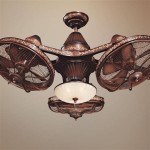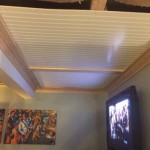Can You Spray Paint an Old Ceiling Fan?
Revitalizing an outdated ceiling fan can significantly enhance a room's aesthetic without the expense of a complete replacement. Spray painting offers a cost-effective and relatively simple method to achieve this transformation. However, the process requires careful preparation and execution to ensure a professional-looking finish and prevent future issues.
Key Considerations Before Spray Painting a Ceiling Fan
Several factors influence the success of a spray painting project. Assessing these beforehand can save time and prevent frustration.
*
Fan Material:
The material of the fan dictates the type of spray paint required. Metal fans typically require metal-specific primers and paints, while plastic fans necessitate specialized plastic-adhesion primers and paints. Using incompatible products can lead to peeling and chipping. *Fan Condition:
Heavily rusted or corroded metal fans require thorough sanding and rust removal before painting. Similarly, peeling or flaking paint on plastic fans needs to be addressed. A smooth, clean surface is crucial for proper paint adhesion. *Location:
Interior and exterior fans have different paint requirements. Exterior fans require weather-resistant paints formulated to withstand UV rays and moisture. Using interior paint on an exterior fan will result in premature fading and deterioration. *Existing Finish:
Glossy finishes require light sanding to create a slightly rough surface for the new paint to adhere to. Flat finishes may not require sanding but always benefit from thorough cleaning.Preparing the Ceiling Fan for Spray Painting
Proper preparation is the most critical step in ensuring a successful and long-lasting paint job.
*
Disassembly:
Remove the fan blades, light fixtures, and any other detachable components. This allows for thorough cleaning and even paint coverage. Labeling each part and screw during disassembly simplifies reassembly. *Cleaning:
Thoroughly clean all surfaces to be painted with a degreaser and a damp cloth. This removes dust, grease, and grime that can interfere with paint adhesion. Allow the parts to dry completely before proceeding. *Sanding:
Lightly sand all surfaces to be painted, even if the existing finish is flat. This creates a slightly rough surface for better paint adhesion. Use fine-grit sandpaper (220-grit or higher) to avoid deep scratches. *Masking:
Use painter's tape and masking paper to protect areas that should not be painted, such as motor housings, pull chains, and any remaining hardware. Careful masking ensures a clean, professional look. *Priming (If Necessary):
Depending on the fan material and existing finish, a primer may be necessary. Primers improve paint adhesion, especially on bare metal or plastic. Apply a thin, even coat of the appropriate primer and allow it to dry completely before painting.Spray Painting Techniques for a Professional Finish
Applying the spray paint correctly is crucial for achieving a smooth, even finish.
*
Thin Coats:
Apply multiple thin coats of spray paint, allowing each coat to dry completely before applying the next. Thin coats prevent drips and runs, resulting in a smoother, more professional finish. *Even Coverage:
Hold the spray can about 10-12 inches away from the surface and move the can in a steady, back-and-forth motion, overlapping each pass slightly. This ensures even coverage and prevents streaks. *Ventilation:
Spray paint in a well-ventilated area or outdoors, wearing a respirator mask to avoid inhaling harmful fumes. Proper ventilation also helps the paint dry faster and more evenly. *Drying Time:
Allow the paint to dry completely according to the manufacturer's instructions before handling or reassembling the fan. Rushing the drying process can result in smudging or imperfections.Choosing the Right Spray Paint
The type of spray paint used significantly impacts the durability and longevity of the finish.
*
Metal Fans:
Use a high-quality metal spray paint formulated for durability and rust resistance. Consider using a rust-inhibiting primer for added protection if the fan shows signs of rust. *Plastic Fans:
Specialized plastic-adhesion spray paints are essential for painting plastic fans. These paints are formulated to bond with plastic and prevent peeling. *Finish:
Choose a finish that complements the room's decor. Common finishes include flat, satin, semi-gloss, and gloss. Each finish has different levels of sheen and durability. *Color:
Select a color that complements the room's color scheme and personal preferences. Consider using a color that contrasts with the ceiling for a more dramatic effect.Reassembling the Ceiling Fan
Once the paint is completely dry, the fan can be reassembled.
*
Careful Handling:
Handle the painted parts carefully to avoid scratching or smudging the finish. Wear gloves if possible to prevent fingerprints. *Reverse Order:
Reassemble the fan in the reverse order of disassembly, referring to the labels made during the disassembly process. *Testing:
Once reassembled, test the fan to ensure it operates correctly. Check for any wobbles or unusual noises, and tighten any loose screws.Safety Precautions
Safety should always be a priority when working with spray paint.
*
Ventilation:
Work in a well-ventilated area or outdoors to avoid inhaling harmful fumes. *Respirator Mask:
Wear a respirator mask designed for paint fumes to protect your lungs. *Eye Protection:
Wear safety glasses to protect your eyes from paint particles and overspray. *Gloves:
Wear gloves to protect your skin from paint and solvents. *Drop Cloths:
Use drop cloths to protect the surrounding area from overspray.
Update A Ceiling Fan Using Spray Paint

Upcycling A Ceiling Fan With Spray Paint Happy Frugal Mama

Another Ceiling Fan Makeover And How Not To Paint A Nani S Notebook

Amazing And Easy Ceiling Fan Makeover With Chas Crazy Creations

How To Update A Ceiling Fan Without Removing It Savvy Apron

Another Ceiling Fan Makeover And How Not To Paint A Nani S Notebook

Ceiling Fan Makeover An Easy Diy Tutorial

Painted Fan Blades A Little Revamp In My Sewing Room

Painting A Ceiling Fan My Repurposed Life

Updating An Old Ceiling Fan 100 Things 2 Do
Related Posts








